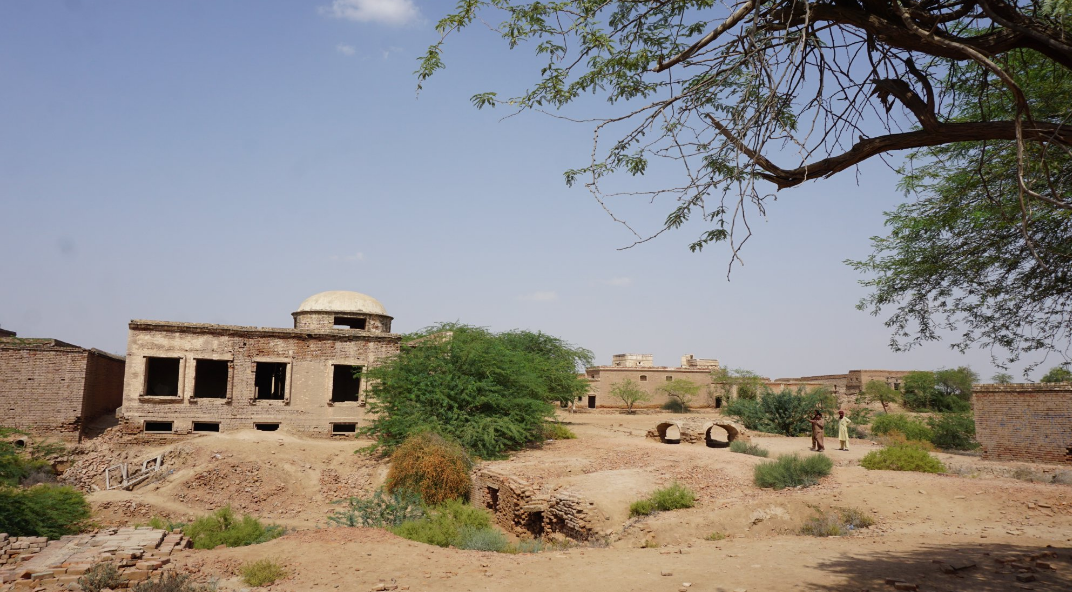Derawar Fort is situated in Bahawlpur state from Ahmadpur East to Shahiwala. It is fully in desert place. There is as much population but fort its has much attraction. It is marvelous visiting place special for those who have interest in history its also a tourist attraction place.

Even the beauty of Cholistan is more than ever. The sun set view in desert is amazing. The best place for camping to enjoy with friends and family.
Fantastic Architect, Must visit place. With this must visit Abbasi Masjid and Nawab's grave yard about 3 minutes drive from Darawar Fort.

Derawar Fort, to the southeast, on the edge of the Cholistan Desert, makes an exciting day's outing from either Ahmedpur East or Bahawalpur. The massive fort towers over the surrounding semi-desert and is visible from miles around.
The huge walls, supported by enormous round buttresses, stand 40 metres (130 feet) high and are 1.5 kilometres (a mile) in circumference. It protected the ancient trade route from central Asia to the Indian subcontinent. The site was captured by the Abassi family from Raha Rawal Singh of Jaisalmer in 1733, at which time the present fort was built.

The whole area around Derawar was once well watered by the Ghaggar River (now called the Hakra in Pakistan, and known in ancient Vedic times as the Sarasvati). Along the 500 kilometres of the dry river bed are over 400 Archaeological sites, most dating back to the Indus Civilization. In the 18th century 12,000 people lived in the y own below the fort walls. Until 1960 Derawar was watered by a canal, but later, under a new international agreement, water from Sutlej River was diverted to India and Derawar was abandoned.

Now the old canal has been cleaned and new canals have dug and you can see farmland surround Derawar, and a paved road has been connected to Ahmedpur East. The fort is more impressive from outside than in. It is a Worth seeing fort. You can also visit some other historical monuments just like White marble mosque in front of the fort was built in 1849 for the Nawab's personal holy man, Pir Ghulam Farid.

The marble and blue tiled tombs of the nawabs and their families lie a few hundred metres to the east of the fort. There is also the elegantly domed marble tomb of the last Nawab's English wife.


Even the beauty of Cholistan is more than ever. The sun set view in desert is amazing. The best place for camping to enjoy with friends and family.
Fantastic Architect, Must visit place. With this must visit Abbasi Masjid and Nawab's grave yard about 3 minutes drive from Darawar Fort.

Derawar Fort, to the southeast, on the edge of the Cholistan Desert, makes an exciting day's outing from either Ahmedpur East or Bahawalpur. The massive fort towers over the surrounding semi-desert and is visible from miles around.
The huge walls, supported by enormous round buttresses, stand 40 metres (130 feet) high and are 1.5 kilometres (a mile) in circumference. It protected the ancient trade route from central Asia to the Indian subcontinent. The site was captured by the Abassi family from Raha Rawal Singh of Jaisalmer in 1733, at which time the present fort was built.

The whole area around Derawar was once well watered by the Ghaggar River (now called the Hakra in Pakistan, and known in ancient Vedic times as the Sarasvati). Along the 500 kilometres of the dry river bed are over 400 Archaeological sites, most dating back to the Indus Civilization. In the 18th century 12,000 people lived in the y own below the fort walls. Until 1960 Derawar was watered by a canal, but later, under a new international agreement, water from Sutlej River was diverted to India and Derawar was abandoned.

Now the old canal has been cleaned and new canals have dug and you can see farmland surround Derawar, and a paved road has been connected to Ahmedpur East. The fort is more impressive from outside than in. It is a Worth seeing fort. You can also visit some other historical monuments just like White marble mosque in front of the fort was built in 1849 for the Nawab's personal holy man, Pir Ghulam Farid.

The marble and blue tiled tombs of the nawabs and their families lie a few hundred metres to the east of the fort. There is also the elegantly domed marble tomb of the last Nawab's English wife.
